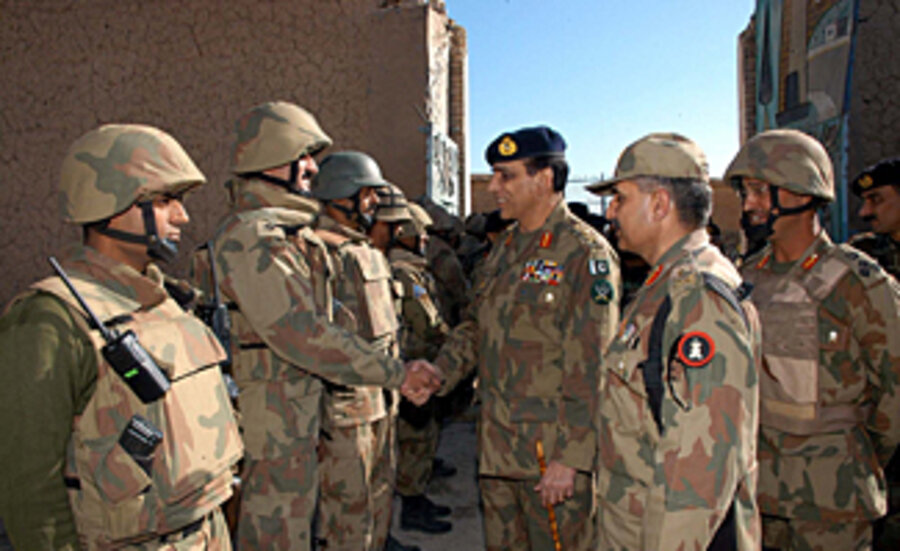Pakistan Army against Taliban: What are the Waziristan goals?
| New Delhi
Pakistan's "South Waziristan offensive" has long had the billing of something epic – a beaches-of-Normandy assault on the mountain caves that form the closest thing to an enemy capital in the war on terror.
In the week and a half since launching its three-pronged attack on the Taliban stronghold, the Pakistan Army claims it has killed more than 160 militants and lost two dozen soldiers. Today, the Army claimed it had killed 42 in its march toward Taliban strongholds. Over the weekend, it recaptured the key town of Kotkai, which has switched hands three times since the offensive began – a sign of the fierce resistance the Taliban is putting up.
Given the Pakistani military's lack of capacity and a diminished enemy, however, analysts suspect Pakistan won't try to reclaim all of South Waziristan. Instead, they say, its aims are more modest and surgical: to eradicate a group of Al Qaeda-linked Uzbek militants and some local supporters.
Those goals need not involve the massive infusion of forces that a counterinsurgency effort would require, nor hold out the prospect of closing down South Waziristan as a militant haven on the border of Afghanistan. Even achieving limited aims, however, could prove difficult – depending on Pakistan's ability to keep other militant factions at bay.
Target the Uzbeks
During talks with security experts before the offensive began, Army Chief Gen. Ashfaq Kiyani "was of the opinion that the dynamics of South Waziristan might change if we can take out the Uzbek fighters," says Imtiaz Gul, a security analyst in Islamabad. "They are the staunchest followers of Al Qaeda ideology, and they are viciously, rabidly anti-Army."
Some 1,000 to 2,000 Uzbek fighters are thought to remain in South Waziristan as part of the Al Qaeda group, Islamic Movement of Uzbekistan (IMU). They fled there from Afghanistan after fighting the US at Operation Anaconda in 2002.
In recent months, both the longtime leader of the IMU and their main hosts in South Waziristan, the Mehsud faction of the Taliban, have lost leaders to drone strikes, Tahir Yuldashev of the Uzbeks and Pakistani Taliban chief Baitullah Mehsud. Their deaths have given the military an opening to squeeze both groups.
Hawks in Pakistan and the US have urged Pakistan to used counterinsurgency to clear tribal areas like South Waziristan of militants, hold them with government forces, and bring development to ensure their future loyalty.
But such visions remain a chimera given the limited number of troops Pakistan has available, argues Sameer Lalwani, author of a new report for the New America Foundation that examines the Army's capabilities to carry out counterinsurgency.
Not enough troops for the job?
His research finds that between 370,000 and 430,000 more troops would be needed to carry out a counterinsurgency across the militant-heavy tribal zone and frontier province. The most Pakistan could free up from its border with India would be 152,000 more. Cobbling together a force of the needed size would take two to five years.
That arithmetic equals a big negative for Western commanders in Afghanistan. "The US and NATO would like some greater control of the [Afghan-Pakistani] border," says Mr. Lalwani. "At some point, the more control you want to have over the border, the more you need a campaign that looks increasingly like counterinsurgency."
Some 28,000 troops are facing off against a force of Uzbeks and Taliban numbering at least 12,000 fighters. "That is going to be a really bloody fight," says Lalwani. "They've had higher force ratios before and it's been pretty bloody for them."
There are further possibilities of unintended escalation. "The danger exists that this becomes a tribal issue," says Shuja Nawaz, a Pakistan analyst with The Atlantic Council, a Washington-based think tank. "If all the Mehsuds see this as an attack against them, this will become a long and drawn-out struggle."





